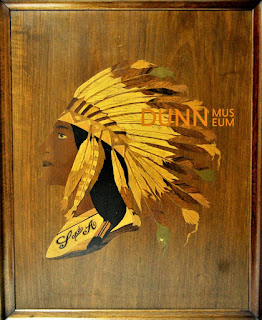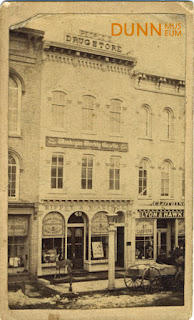Years
before settling in Waukegan and teaming up with Benny, Cora Salisbury enjoyed
fame on the vaudeville circuit.
Vaudeville
entertainment was popular from the mid-1890s to the early 1930s. Most
vaudeville acts were part of a troupe of about a dozen individuals who traveled
from town to town. Their acts included magic, acrobatics, juggling, comedy,
music, song and dance, and trained animals.
Cora was
born to Eliza A. Knofsker and James H. “Harry” Folsom on February 13, 1868, in
Oshkosh, Wisconsin. Her father’s untimely death in 1883 prompted her mother to earn
a living providing meals and lodging in their home. Many of their boarders were
part of traveling theatrical troupes. These artists inspired a teenage Cora to
learn about contemporary music and the stage, leading her to pursue a career as
a musician and entertainer.
In 1888, Cora married newspaperman Charles P. Salisbury, who changed careers to manage theaters and a musical theater troupe in New York. In 1892, Cora began performing with the troupe as a pianist and elocutionist—using her voice, gestures, and comedic timing to entertain.
In 1903, after
divorcing her husband for “non-support,” she set out on a solo tour of
vaudeville houses in the upper Midwest as Miss Cora Folsom Salisbury. Her act
featured an “artistic pianologue” that blended comedy with her original ragtime
piano compositions.
On her
return to Oshkosh in late 1907, the local newspaper heralded her success: “Miss
Salisbury has an act that is absolutely new. It is also irresistibly funny. She
is a good-looking little woman, but is willing to sacrifice her good looks and
graceful carriage at times to amuse the public.”
After 16 years on the vaudeville circuit, Cora had a chance to settle down. In April 1908, she moved to Waukegan to become the musical director for the recently opened Barrison Theatre on Sheridan Road. There, her knowledge of music and performance was admired.
In the musical director position, Cora performed as a pianist with Barrison’s orchestra and as a solo act. Her role also included playing music for each artist’s act along with “subtle interpretation” piano accompaniment during the showing of silent motion picture films.
The Waukegan
Daily Sun gushed at her first solo performance on June 25, 1908, stating,
“She is a vaudeville artist of rare talent, of charming stage mannerisms… We
feel she belongs to Waukegan.”
On that same night, the Waukegan Junior Orchestra played at the Barrison. Among its musicians was a 14-year-old Benjamin Kubelsky on violin. This was possibly the first time Cora Salisbury met the future Jack Benny.
In January 1909, “Bennie Kubelsky” made his debut performance as an act at the Barrison. The following year, he joined the Barrison Orchestra under Salisbury’s direction.
In 1910, three vaudeville theaters in Waukegan merged into the Greater Barrison Vaudeville group, and Cora continued as "musical directress."
In addition to her work as musical director, Cora composed music and earned an income from her copyrighted compositions. Before recordings were available, composers earned a living through sales of their sheet music. In 1911, her “Lemons and Limes Rag” was a big hit, and “Ghost Dance” was played at the Majestic Theatre in Chicago and “heralded as the greatest characteristic orchestra number written in years.”
Hein’s
department store in Waukegan hired her to “take charge” of its music
department. To promote and sell music, many department stores employed a “song
plugger” to play sheet music for patrons to purchase. Cora Salisbury was among many
noteworthy “pluggers” nationwide, including George Gershwin and Irving Berlin.
In February
1911, Cora was the musical director for the Elks Minstrel Show at the
Schwartz Theatre in Waukegan. The Daily Sun wrote that Salisbury is a
“mistress of a sorcery of the keys which carried the entire show through to a
vast success.” Benny Kubelsky, the “rag time violinist,” also appeared at the
show.
Shortly after this performance, Cora convinced Benny’s parents, Meyer and Emma Kubelsky, to allow him to tour with her.
That summer,
the duo set out on a coast-to-coast tour with their act “Salisbury and Benny: From
Grand Opera to Rag Time.” The 43-year-old Salisbury enjoyed returning to her
roots while mentoring the promising 17-year-old on his first vaudeville tour. For
their performance at the Bijou Theater in Kenosha, Wisconsin, Benny was billed
as “The Fiddlin Kid.”
On breaks
in 1912 and 1913, they returned to Waukegan, where they performed at Neal’s
Candy Shop and the Hein’s Store.
In February 1913, a review of Salisbury
and Benny’s performance at the Hippodrome in Lexington, Kentucky, described the
19-year-old Benny as “a rather lazy looking youth." The reviewer went on to say that Benny "holds his violin as if it
might weigh a few hundred pounds, but nevertheless he gets the music… every
time he pulls his bow across the strings, he either gets a howl from his
audience or they sit entranced.”
By early 1914, the pair’s touring and partnership concluded. The most significant contributing factor was likely the need for Cora to remain in Waukegan to care for her ailing mother, Eliza. Over the years, Cora had also suffered from bouts of facial neuralgia.
On February 5, Cora and Benny made one final appearance on the same stage—though as separate acts—for the Waukegan YMCA’s charity event.
On October 4, 1914, to the surprise of her friends, and at the age of 46, Cora married Navy Warrant Officer George L. Aulmann (1867-1939).
Cora Salisbury Aulmann continued as a pianist and composer at local venues and parties. In March 1915, she gave up her position at the Barrison Theatre due to her declining health and the strain of looking after her mother, who passed away later that year.
In January 1916, Cora sold her Schiller piano and left for sanitariums in Chicago and Fond du Lac, Wisconsin, seeking to improve her health. On her return trip to Waukegan with her husband, she became ill with peritonitis and was hospitalized.
On April 16, 1916, Cora Salisbury Aulmann died at the Jane McAlister Hospital in Waukegan.
Her husband, George Aulmann, noted in the Waukegan Daily Sun after her death: "My wife improved so much under the treatment at Fond du Lac that both she and I were confident that she was going to get well."
Cora Salisbury found her home in theater venues and the laughter and applause of appreciative audiences. She was a talented vocalist, pianist, and a rare female ragtime composer whose comedic timing may have influenced Jack Benny’s comedy skits.
Her legacy may best be remembered in the success of her protégé. Those early years in Waukegan and on the road with Cora were crucial to Jack Benny’s career. No wonder he always spoke of his mentor with kindness and gratitude.
Women often held supporting roles in vaudeville, but Cora Salisbury broke the mold with her successful solo “pianologue” act and equal partnership with Jack Benny.
Check out the DunnTV Historymakers: Cora Salisbury video on YouTube.
- Diana Dretske, Curator ddretske@LCFPD.org
Sources:


The_Oshkosh_Northwestern_15%20April%201887_Page_4_underscore.jpg)














%20photo%20by%20alan%20light_wiki%20commons.jpg)



































